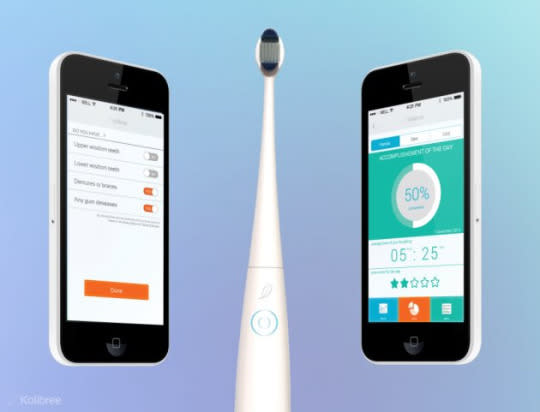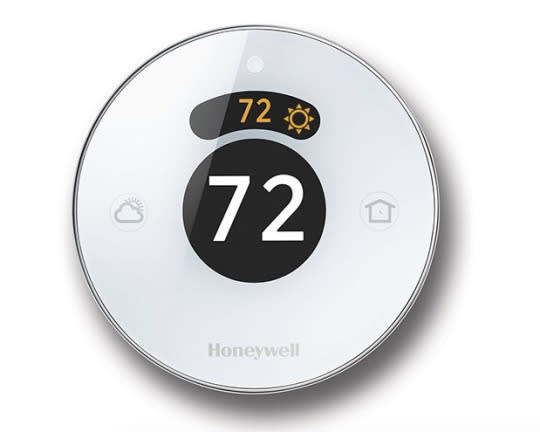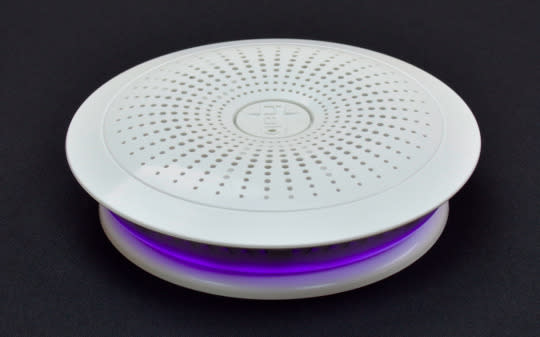Biggest Challenge in Making Your Home Smarter? Getting Gadgets to Talk to Each Other
The problem with smart home technology in 2016 isn’t a lack of intelligence; it’s a failure to communicate.
As more new ‘smart’ devices appear — and we saw a passel of them last week at CES 2016, from smart showers to beds, belts, blenders, toothbrushes, and more — the same stumbling blocks remain. All of them will talk to your smartphone, but most of them won’t talk to one another.

Kolibree Smart Toothbrush (Photo: Kolibree)
To get the most Jetsons-like experience from your smart home, devices need to speak the same language. If you want your smart bed to notice when you are awake, open your smart blinds, tune your smart audio system to Morning Edition, and tell your smart coffeemaker to start brewing, all of these devices need to communicate on the same radio frequency using the same protocols.
At the moment, though, there are more than half a dozen smart home systems — like Apple HomeKit, Samsung’s Smart Things, Google’s Brillo, Lowe’s Iris, and AllJoyn — using a variety of wireless protocols, such as WiFi, Zigbee, and Z-Wave. That’s just a partial list.
Some devices can work across multiple languages and frequencies, but many don’t. So consumers will be left trying to figure out whether the new smart shower they just bought will talk to their smart water heater. Otherwise, they’ll end up with a bunch of incompatible devices and have to use a different smartphone app to control each one. Who needs this kind of grief?
Sadly, CES 2016 offered no easy one-size-fits-all solution to this conundrum. Basically you have two options: Commit to one smart home ecosystem for everything, or rely on vendors to provide point-to-point connections between individual devices.
No place like HomeKit
CES 2015 saw the first gadgets build around HomeKit, the smart home ecosystem Apple introduced in June 2014, which lets you use its Siri voice assistant and an iPhone or iPad to control devices.

The Honeywell Lyric smart thermostat — not to be confused with the Nest. (Photo: Honeywell)
This year’s show saw a number of new ones, like Onelink by First Alert, a Wi-Fi-connected smoke and CO2 monitor that can respond to voice commands. Another is the Honeywell Lyric thermostat, which looks like a Nest but without the Google connection. Other new HomeKit gadgets include the Kwikset Premis smart lock, Hunter ceiling fans, and wall switches from iDevice. Still, the number of HomeKit devices remains relatively small.
Samsung gets smarter
Since it acquired SmartThings in August 2014, Samsung has moved aggressively toward expanding the SmartThings ecosystem and building the technology into its appliances. It has also kept SmartThings open to any manufacturer or app maker that wants to play along, helping to create a network of more than 20,000 developers.
This year the Korean electronics giant displayed several new appliances that work in the SmartThings ecosystem, including a line of smart TVs alongside a smart USB stick to plug into older sets, a refrigerator, an oven, and the SleepSense, a disc-shaped sensor that sits under your mattress and can control devices automatically based on your sleeping patterns.

Samsung’s SleepSense. (Photo: Samsung)
Even Samsung’s bitter rival, LG Electronics, hopped aboard the SmartThings train this year, announcing its SmartThings Hub, a gadget that lets you use your voice to control various home devices. LG did not announce pricing or availability for the Hub, which looks an awful lot like Amazon’s voice-activated assistant/wireless speaker, Echo. (Amazon Echo joined the SmartThings ecosystem last August.)
Highs and Lowes
For the past few years, DIY smart home aficionados have been able to get a decent range of plugs, switches, sensors, and other smart home devices at their local Lowe’s hardware store. All of these devices are built by third parties and compatible with Lowe’s Iris home automation system.
New this year from Lowe’s is Halo, a $130 voice-driven smoke detector that talks to you when it detects smoke and can issue weather alerts. Lowe’s also announced a $20 per month home monitoring service, which can send first responders to your home when Iris sensors detect smoke or water leaks.

Lowe’s Halo smart smoke detector. (Photo: Lowes)
Last fall, Lowe’s announced Iris 2.0, which includes support for the open AllJoyn protocol, which allows other AllJoyn-certified devices to work with the Iris system. CES 2016 saw more than a dozen AllJoyn products announced, including security cameras, light bulbs, and humidifiers.
Point-to-point solutions
Another tactic smart home vendors are adopting is to simply connect their smart device to another widely used one, typically Google’s Nest smart thermostat, Nest Cam (formerly Dropcam), or Amazon Echo, which lets you use the Alexa Voice Service to control a range of home devices.
For example, Chamberlain, makers of smart garage door openers, announced integration with the Nest Cam, so homeowners can now see who’s opening their garage door when they’re not home.

Amazon’s Echo, powered by Alexa. (Photo: David Pogue/Yahoo Tech)
A number of vendors announced support for Alexa at this year’s CES, including Nexia’s home automation hub, Invoxia’s Triby Bluetooth speaker, and Vivint’s entire smart appliance lineup. Even Ford got into the act, announcing that it is “exploring” making its SYNC car communication system compatible with Alexa. Soon you may be able to talk to your Ford Fusion, just like in the TV show My Mother the Car.
The smart move
If you’re desperate to automate your entire home over the next 12 months (because, apparently, you have unlimited amounts of time and money), the smartest thing to do would be to go for devices that work with an open ecosystem, like SmartThings or AllJoyn. If you’re the all-Apple-all-the-time type, you’ll probably be happy sticking with HomeKit devices and adding new ones as they come along.
Otherwise your best option is to start with the one thing you most want to automate — like your HVAC, home entertainment, or security system — and add compatible devices as they appear.
Bottom line: Smart home technology is getting smarter every year, but it just needs to learn how to play nicely with others.
Editor’s note: This story has been updated to correct inaccuracies in describing the various smart home systems and protocols.
More from CES 2016:
HTC and UnderArmor’s HealthBox is an All-in-One Fitness Tracking System
HTC Debuts Improved Vive Pre VR Headset with Front-Facing Camera
Samsung Goes After Microsoft, Apple With Win 10 Tablet and Laptops
Toyota Spending $1 Billion to Develop AI-Driven Cars, Robots for the Home
Ford Says It Will Have Self-Driving Cars and Smart-Home Integration by 2020
4 Big Trends at CES 2016: Cars, Wearables, Laptops, and Accessories for Everything
LG’s See-Through, Rollable OLED Screens: Here, But Not Cheap
Meet CleverPet, the Electronic Game That’s Like ‘Simon’ For Dogs
Dan Tynan is now back from CES and plans to sleep for the next three days.
